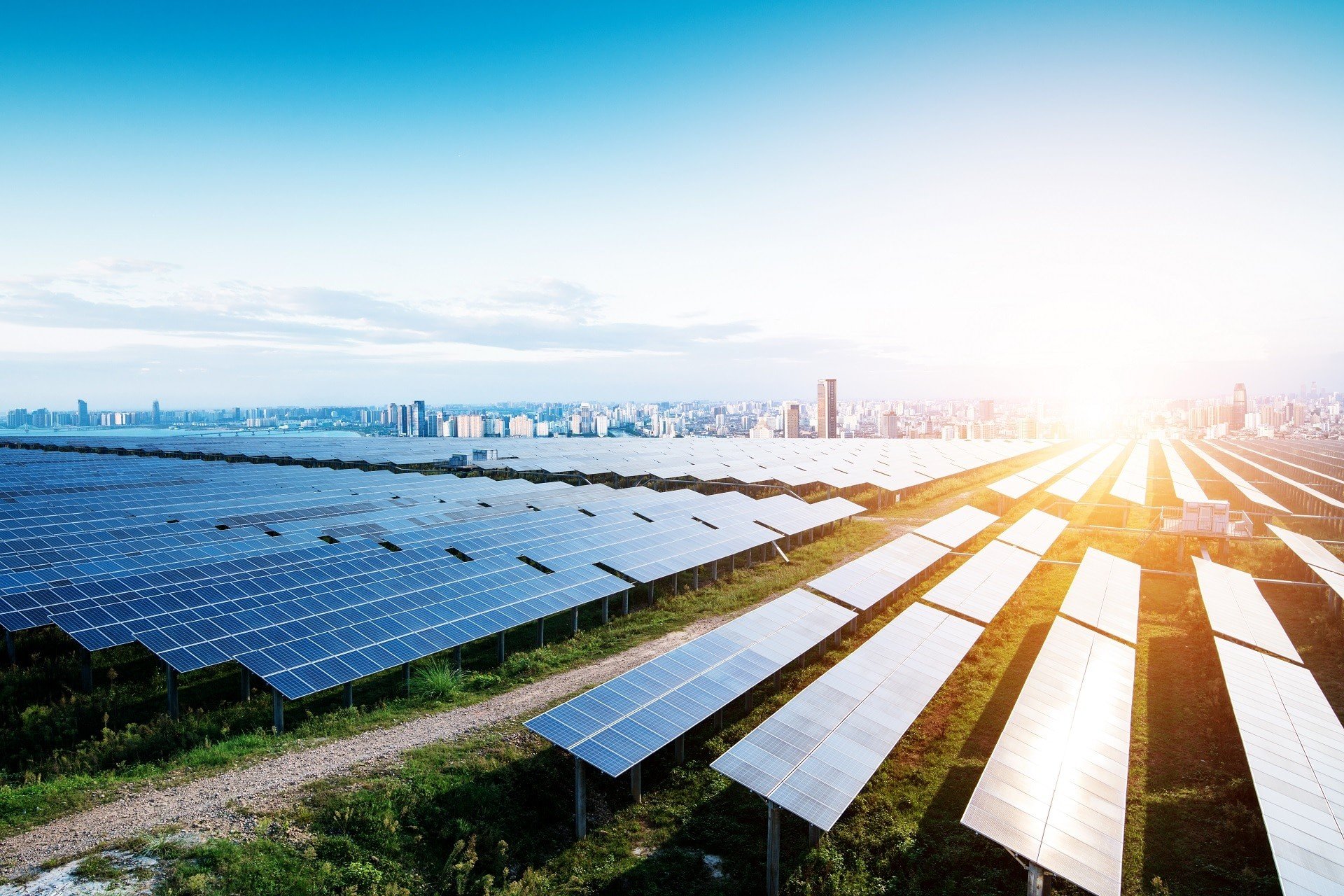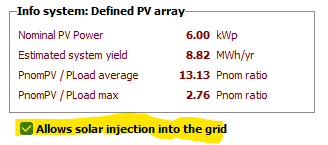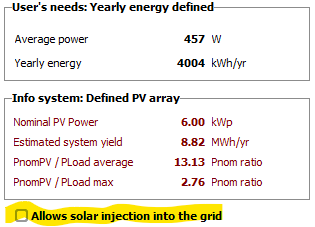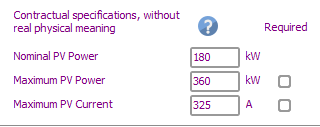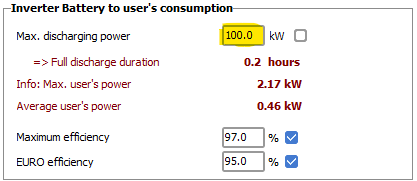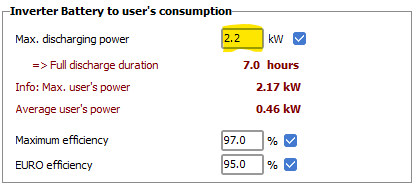-
Posts
2069 -
Joined
-
Last visited
Everything posted by André Mermoud
-
What dou you mean by "Types of cables" ? The different types of cable (of a same metal) have in principle the same resistivity, and this is the parameter which determines the power loss. If you are talking about the installation mode: - The resistivity may indeed depend on the cable temperature, and therefore on the installation mode. - The main thing to be considered will be the current limit for a given cross section, which is specified in norms.
-
In the DC circuit (array of strings), the total wire length is indeed the lenght of the whole loop (this si mentioned just below "Please specify the total wire length for each circuit. " For the AC circuit, this is the line length (distance between devices).
-

mismatching night consumption at same AC capacity
André Mermoud replied to mohaned's topic in Simulations
Probably you have defined your transformer by a generic relative loss, i.e. proportional to the transformer nominal power. And this nominal power - evaluated by PVsyst on the basis of the PNomPV at STC, or the PNomac (this is your choice in the Project's settings) - has been changed in your different runs. This should not arise if you define an explicit transformer from the datasheets, the nominal power of the transformer will always remain the manufacturer's value. In this case the "generic" relative values will be updated as a function of this real Transformer nominal power. -
There may be new features in the version 8, which were not implemented in the version 7. Now for the modification of the Rshunt and Rserie values, this was a feature of the software which has been mpdified. In the version 7, when they were judged not quite correct, these values were updated to default ones. This is no more the case in the version 8.
-
The files created in the V8 cannot be used with the version 7.
-
You can add a battery in your database from scratch by using "Databases => Batteries => New". But you are strongly advised to choose a similar battery in the database, modify its parameters according to your own component datasheets, and save this as a new battery. For defining an hybrid system, you should choose the button "Storage" in the project's dialog, and probably choose the option "Self consumption" for your case.
-
No, in the present time PVsyst doesn't consider the charging of the battery from the grid.
-
This is quite normal as you have defined a grid limitation of 1 kW (for a system of 200 kWp, 180 kWac). You can notice that the apparent value is 79 kVah, to be compared to a global delivery to the user of 224 MWh, i.e. 0.04%. Please note that you have the opportunity of completely forbid the injection to the grid when you define the self-consumption:
-

Battery being under-utilized in self-consumption simulation
André Mermoud replied to Dean O's topic in Problems / Bugs
Yes indeed, the battery model of PVsyst uses information which is not always present on the datasheets. Some datasheets are really very brief. When you have to define a battery by yourself, you are advised to start from an existing battery, and adjust the relevant variables (mainly technology, kind of battery, number of cells in series and parallel, internal resistance (check dafault), self-discharge (check default), lifetime (numbe of cycles), sizes and weight -

about PV module ageing parameters : Imp/Vmp contributions
André Mermoud replied to Chen's topic in Problems / Bugs
You can find some data about the current and voltage degradation in the works, namely, of the TISO in Switzerland. For example in this publication: https://www.researchgate.net/publication/256080133_TISO_10_kW_30_years_experience_with_a_PV_plant -
We obviously don't avail of detailed ageing data for a specified PV module. The average degradation rate itself is really not well defined. In the literature you can find a wide panel of values (0.3% to 1%/year). The PVsyst proposition of 0.4% seems a reasonable choice for usual modules. The specific mismatch effect due to ageing has been developed "theoretically" as a tool in PVsyst, without any experimental basis. We don't know any publication studying this problem in the literature. The hypotheses under this evaluation (Monte Carlo evaluation of the dispersion progress) are purely speculative. Therefore this model is obviously not able to take your particularity into account in a reliable way. You can probably take a lower value for the Isc/Vos RMS.
-
The PVsyst proposition doesn't take the maximum current into account. It is your job to check it in your final design. However the maximum current of a PV array is not well defined: the value corresponds to the STC (1000 W/m2), but if the inverter is specified for a given maximum current, it will limit the array current during operation, by displacing the operating point on the I/V curve. By the I don't see where you find that maximum current of 180 A. The manufacturer specifies 325 A in the PVsyst database: Your configuration of 15 strings of 25 modules of 650 Wp represents a PV power = 243 kW, i.e. a current of 238 A under 1020 V at STC.
-

Sudden Load Profile Spikes After Importing File
André Mermoud replied to Ady's topic in Problems / Bugs
Please remember that we are working in hourly values. And the thresholds according to the battery SOC may arise during the hour, so that the transition from an operating state to another one may arise during the hour. Therefore you can have a "Battery full" state at the beginning of the hour, and a discharge during the rest of the hour. However there is also a visual artefact because you are showing lines from the middle of hour to the middle of the next hour. In your first plot, at 13:30 you have unused energy, but no BESS discharge. At 14:30, you have BESS discharge, but no Unused energy. The intermediate lines don't have any meaning. -
First of all, the inverter's behaviour with grid voltage deviations is very rarely described in the datasheets, and probably different for each inverter. By the way, PVsyst doesn't treat possible Grid voltage variations along the time. This is not part of the input variables, and we really don't see from which source we could evaluate it in prevision simulations.
-
I don't see what you mean by "some modules are overlapping". For filling your field, you can do that manually by the mouse. But you can possibly use the option "Attribution automatique" (you have many options for doing this), and than correct what seems not suited for you, by exchanging/dragging the string attributions with the mouse.
-
The answers to your questions are fully explained in the help: https://www.pvsyst.com/help/project-design/array-and-system-losses/ageing-pv-modules-degradation/index.html?h=ageing https://www.pvsyst.com/help/project-design/array-and-system-losses/ageing-pv-modules-degradation/module-performance-degradation.html 1. - ISC dispersion has nothing to do with the datasheets information. Its nature is explained in the help. 2. - You can evaluate the effect of the Current and Voltage degradation weighting by yourself, by excuting several simulations. You will see that this is not very significant. 3. - When you have one only module, it is quite obvious that you don't have any mismatch loss. 4. - In the ageing process, the mismatch between "degraded" modules increases along the time. 5. - This is an input parameter. The global degradation is the sum of the individual PV modules degradation and the increasing mismatch.
-
Sorry, I really don't understand your strategy. It is not the battery (or the Ecoflow) which decides when it starts charging or discharging, but the external conditions (user's needs or PV availability). Starting discharging at a given SOC doesn't make sense without a clear definition of the energy demand. PVsyst controls the the charging or discharging "autorizations" as a function of the SOC evolution. If you are discharging (drawing energy), the battery will stop delivering power when the SOC reaches the specified threshold "Minimum discharging". When you are charging, PVsyst will disconnect the PV production when the SOC attains the specified "Maximum charging". This may arise within hours, You have a part of the hour in one state, and another part in the other state.
-
Thank you for sending your project. However it doesn't show the same output as you have shown here: The message tells you that the maximum discharging power is highly undersized. Your load definition has many hours with a load demand of around 21.3 MW, including during night, and you limit the discharging power to 10 MW. When I specify 22 MW as a discharging power, as you did in your previous message, I don't see any error nor warning anymore.
-
The voltage drop of a PV array doesn't make much sense, as when the R*I² loss increases, the Pmpp will move on the I/V curve, and therefore the current will also be modified. PVsyst doesn't provide any guidelines for this difference between Power loss and Voltage drop, which depends on the I/V curve. We consider that the voltage drop is not defined, and of no interest in the case of I/V curves.
-
The EcoFlow is a grid-tied inverter, which can only be used (in PVsyst) in a grid-connected system. Now if you want to use it in a stand-alone system - which is probably more suited for your very special use - you should define it as a "Controller for Stand-alone" in the database. But the problem of the user's needs definition remains the same: you have to define it, whatever the way you are using the produced energy. The battery needs to "know" when it has to be charged or discharged.
-
Sorry, I can't understand that. Please send us your full project, using "Files => Export project" in the main menu. Send it by e-mail to support@pvsyst.com, and tell us in which variant you have this problem.
-
This concerns the inverter at the output of the battery pack. On the next page "Self consumption", please define the "Max. discharging power". As a first step, you can ask the default value proposed by PVsyst according to your consumption profile (checkbox on the right).
-
The Stand alone systems simulation in PVsyst is based on a balance between the PV production, the user's consumption and the intermediated battery for ensuring a match at each instant between these two energy systems. Therefore if you don't define the user's needs, the simulation cannot work, and I really don't see what you want to obtain as a result. Now if you consider this as a grid-connected system with storage, this should be a self-consumption system, and the problemremains the same: without self-consumption definition this doesnt make sense. You can indeed consider a grid-connected system, without storage, for the evaluation of the possible PV yield. This will not involve the battery. The battery behaviour is obviously dependent on when you will consume this energy, therefore on the user's needs definition. i

